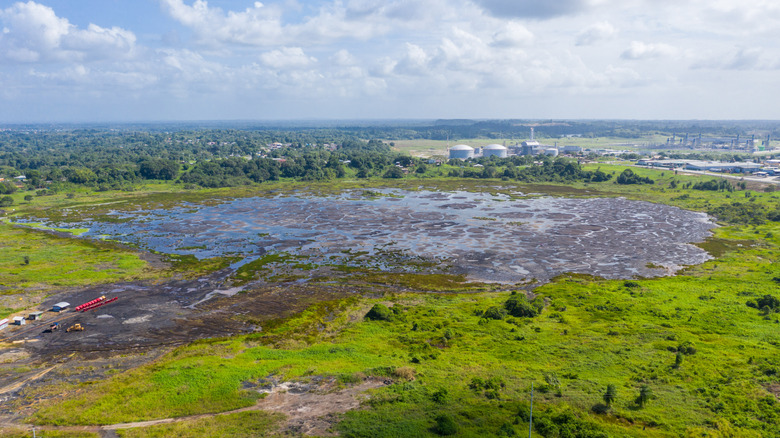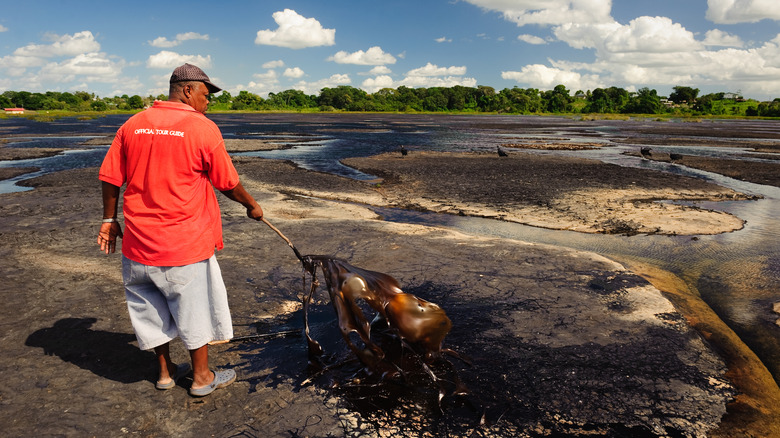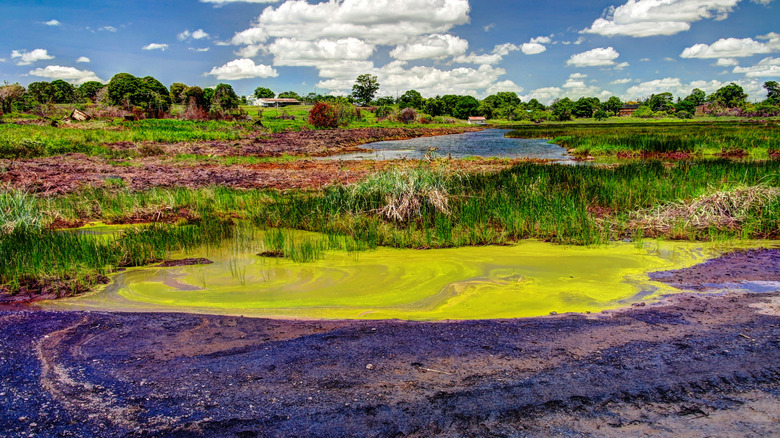The 'Wonder Of The Caribbean' Is A Bizarre, Dangerous Lake With Supposed Alien-Like Creatures
Natural beauty comes in all shapes and sizes. Whether it's the vibrant pink lagoons of Las Coloradas in Yucatán, Mexico or the crooked forests in Poland, there are mysterious places across the globe that showcase just how weird and wonderful the natural world can be. And there are few spots more bizarre than Trinidad's Pitch Lake, called "the wonder of the Caribbean."
Trinidad might be one of the most stunning islands in the Caribbean, but "the eighth wonder of the world" is hardly what you'd call beautiful. Located in the southwestern part of the island, just outside the small town of La Brea, Pitch Lake is one of the most unusual attractions in the Caribbean. Around 50 miles from Piarco International Airport, Trinidad's main flight hub, it takes just over an hour to reach by car for visitors arriving on the island, and a similar amount of time from Port of Spain, the capital city. It's a pleasant drive down the west coast, passing the Caroni Swamp Bird Sanctuary, the city of San Fernando, and the gorgeous Vessigny Beach, before arriving at La Brea.
Pitch Lake is an eerie, alien place. An oozing, boiling, thick mass of liquid asphalt, stretching out across an area of more than 100 acres (about 90 football fields) and descending over 250 feet in places. It is one of the most popular tourist sights in Trinidad, a remarkable wellspring of scientific research, and an immensely important part of the island's economy throughout its history.
Oozing evidence of life on other planets found in Pitch Lake
Pitch Lake is the largest naturally-occurring deposit of bitumen (normally called asphalt or tar) in the world, with over 6 million tons of the thick, black substance bubbling up from below the ground. Scientists believe that it bubbles up from beneath the Earth's core through a gap between tectonic plates, and is formed by gases converted to viscous oil through pressure and time.
Remarkably, there is life in this seemingly inhospitable pit. Microscopic organisms have been discovered surviving within tiny droplets of water beneath the surface of the black gunk, something that was previously considered to be impossible. The discovery of these microbial ecosystems has led to the theory that similar environments on other planets could support similar habitats — one of the biggest indications of the possibility of alien life in our solar system!
While you can't swim in Pitch Lake, you can actually walk on it in some spots! Where time has solidified older parts of the surface, the asphalt is strong enough to support a person's weight. Strolling across the lake is a bizarre, disconcerting, yet incredibly exciting thing to do. It is worth wearing old shoes you are happy to ruin, and always go with a guide, as some areas are softer than others, and sinking beneath the surface of the tar pit would not be a pleasant experience.
Building roads from Trinidad to New York and London
The Indigenous people of Trinidad believed that the Pitch Lake appeared as a divine punishment for a tribe who ate sacred hummingbirds, swallowing their village whole and remaining as a permanent stain on the landscape. It was first discovered by Europeans when Sir Walter Raleigh led an expedition to the West Indies in 1595 — he was delighted with the discovery and immediately used the tar to repair his ships.
While today, asphalt can be created synthetically, historically, it has come from places like Pitch Lake. As a result, the lake has been a source of significant income over the years and has contributed to some important projects. Many of the roads in New York, Washington, and other East Coast cities were first paved with asphalt from Pitch Lake, as were several in Central London.
While the main draw of Pitch Lake is its weirdness and otherworldly atmosphere, it is a charming spot for all sorts of other reasons and makes a fantastic island day trip. Despite its grim, uninhabitable appearance, the countryside surrounding Pitch Lake is filled with a rich variety of plants and animals, making it a paradise for nature lovers. The watery marshes that surround the tar center of the lake are dotted with water roses, nymph lilies, and Bird of Paradise flowers, while the surrounding trees are home to heron, kingfishers, sandpipers, and, of course, hummingbirds!


